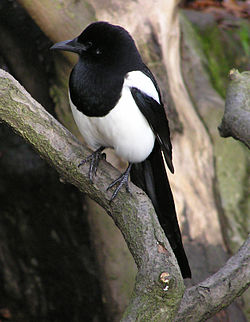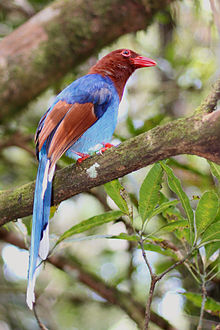- Magpie
-
This article is about the birds in the family Corvidae. For the Australasian bird in the family Artamidae, see Australian Magpie. For other uses, see Magpie (disambiguation).
Magpies 
European Magpie Scientific classification Kingdom: Animalia Phylum: Chordata Class: Aves Order: Passeriformes Family: Corvidae Genera Magpies are passerine birds of the crow family, Corvidae.
In Europe, "magpie" is often used by English speakers as a synonym for the European Magpie, as there are no other magpies in Europe outside Iberia. That bird was referred to as a "pie" until the late 16th century when the feminine name "mag" was added to the beginning.[1]
Magpies are believed to be one of the most intelligent of all animals: the European Magpie is one of the few animal species known to be able to recognize itself in a mirror test.[2]
Contents
Systematics and species
According to analysis,[3] magpies do not form the monophyletic group they are traditionally believed to be—a long tail has certainly elongated (or shortened) independently in multiple lineages of corvid birds. Among the traditional magpies, there appear to be two distinct lineages: one consists of Holarctic species with black/white coloration and is probably closely related to crows and Eurasian jays. The other contains several species from South to East Asia with vivid coloration which is predominantly green or blue. The Azure-winged Magpie is a species with a most peculiar distribution and unclear relationships. It may be the single survivor of a long extinct group of corvid genera.[citation needed]
Other research[4] has cast doubt on the taxonomy of the Pica magpies, since it appears that P. hudsonia and P. nuttalli may not be different species, whereas the Korean race of P. pica is genetically very distinct from the other Eurasian (as well as the North American) forms. Either the North American, Korean, and remaining Eurasian forms are accepted as three or four separate species, or there exists only a single species, Pica pica.
Holarctic (black-and-white) magpies
- Genus Pica
- European Magpie, Pica pica
- Black-billed Magpie, Pica hudsonia (may be conspecific with P. pica)
- Yellow-billed Magpie, Pica nuttalli (may be conspecific with P. (pica) hudsonia)
- Korean Magpie, Pica sericea (may be conspecific with P. pica)
Oriental (blue/green) magpies
- Genus Urocissa
- Formosan Blue Magpie Urocissa caerulea
- Red-billed Blue Magpie, Urocissa erythrorhyncha
- Gold-billed Magpie, Urocissa flavirostris
- White-winged Magpie, Urocissa whiteheadi
- Sri Lanka Blue Magpie, Urocissa ornata
- Genus Cissa
- Green Magpie, Cissa chinensis
- Yellow-breasted Magpie, Cissa hypoleuca
- Short-tailed Magpie, Cissa thalassina
Azure-winged Magpie
- Genus Cyanopica
- Azure-winged Magpie, Cyanopica cyana
Other "magpies"
- The Black Magpie, Platysmurus leucopterus, despite its name, is neither a magpie nor, as was long believed, a jay, but a treepie. Treepies are a distinct group of corvids externally similar to magpies.
- The Australian Magpie, Cracticus tibicen, is conspicuously piebald, with black and white plumage reminiscent of a European Magpie. It is a member of the family Artamidae, and not a corvid.
References
- Notes
- ^ Funk & Wagnalls Wildlife Encyclopedia, Volume 11, 1974, p. 1339.
- ^ Prior H. et al. (2008). De Waal, Frans. ed. "Mirror-Induced Behavior in the Magpie (Pica pica): Evidence of Self-Recognition". PLoS Biology (Public Library of Science) 6 (8): e202. doi:10.1371/journal.pbio.0060202. PMC 2517622. PMID 18715117. http://biology.plosjournals.org/archive/1545-7885/6/8/pdf/10.1371_journal.pbio.0060202-L.pdf. Retrieved 2008-08-21.
- ^ Ericson et al. (2005)
- ^ Lee et al., 2003
- Bibliography
- Anonymous (2006): The Word Origin Calendar: Sat./Sun. March, 11–12, 2006. Accord Publishing.
- Ericson, Per G. P.; Jansén, Anna-Lee; Johansson, Ulf S. & Ekman, Jan (2005): Inter-generic relationships of the crows, jays, magpies and allied groups (Aves: Corvidae) based on nucleotide sequence data. Journal of Avian Biology 36: 222–234.
- Lee, Sang-im; Parr, Cynthia S.; Hwang, Youna; Mindell, David P. & Choe, Jae C. (2003): Phylogeny of magpies (genus Pica) inferred from mtDNA data. Molecular Phylogenetics and Evolution 29: 250–257.
External links
- Magpie videos, photos and sounds on the Internet Bird Collection
Extant species of family Corvidae Kingdom: Animalia · Phylum: Chordata · Class: Aves · Subclass: Neornithes · Superorder: Neognathae · Order: PasseriformesFamily Corvidae Choughs Treepies PlatysmurusTemnurusOriental
magpiesOld World jays PtilostomusStresemann's
BushcrowZavattariornis
Categories:
Wikimedia Foundation. 2010.
Look at other dictionaries:
Magpie — Mag pie, n. [OE. & Prov. E. magot pie, maggoty pie, fr. Mag, Maggot, equiv. to Margaret, and fr. F. Marquerite, and common name of the magpie. Marguerite is fr. L. margarita pearl, Gr. ?, prob. of Eastern origin. See {Pie} magpie, and cf. the… … The Collaborative International Dictionary of English
Magpie — (engl. für „Elster“) bezeichnet: Magpie (Québec), Dorf in der Gemeinde Rivière Saint Jean in der Regionalgemeinde Minganie, Québec, Kanada Rivière Magpie, Nebenfluss des Sankt Lorenz Stroms in Québec, Kanada Magpie River, Fluss zum Oberen See in… … Deutsch Wikipedia
Magpie — ( Pie bavarde en français) est un village du Québec, au Canada, située sur la Cote Nord, entre Rivière au Tonnerre et Rivière Saint Jean. Il est une localité dans la municipalité de Rivière Saint Jean. Magpie compte près de 200 habitants[1].… … Wikipédia en Français
magpie — (n.) the common European bird, known for its chattering, c.1600, earlier simply pie (early 13c.); first element from MAG (Cf. Mag), nickname for Margaret, long used in proverbial and slang English for qualities associated generally with women,… … Etymology dictionary
magpie — ► NOUN 1) a long tailed bird of the crow family with pied plumage and a raucous voice. 2) a black and white Australian butcher bird with musical calls. 3) a person who obsessively collects things or who chatters idly. ORIGIN probably a shortening … English terms dictionary
magpie — [mag′pī΄] n. [< Mag, dim. of MARGARET + PIE3] 1. any of several jaylike corvids, passerine birds characterized by black and white coloring, a long, tapering tail, and a habit of noisy chattering 2. a person who chatters 3. a person who… … English World dictionary
magpie — /mag puy /, n. 1. either of two corvine birds, Pica pica (black billed magpie), of Eurasia and North America, or P. nuttalli (yellow billed magpie), of California, having long, graduated tails, black and white plumage, and noisy, mischievous… … Universalium
magpie — /ˈmægpaɪ / (say magpuy) noun 1. Also, Australian magpie. a common black and white bird, Gymnorhina tibicen, with a solid body, strong legs, and a large pointed bill, found throughout Australia and in New Guinea, and noted for its beautiful song… …
magpie — [17] The original name of the magpie was simply pie, which came via Old French from Latin pīca. This is thought to go back ultimately to Indo European *spi or *pi , denoting ‘pointedness’, in reference to its beak (the Latin masculine form, pīcus … The Hutchinson dictionary of word origins
magpie — [[t]mæ̱gpaɪ[/t]] magpies 1) N COUNT A magpie is a large black and white bird with a long tail. 2) N COUNT If you describe someone as a magpie, you mean that they like collecting and keeping things, often things that have little value. [INFORMAL]… … English dictionary
- Genus Pica


